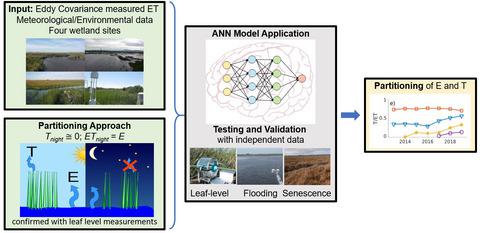当前位置:
X-MOL 学术
›
Glob. Change Biol.
›
论文详情
Our official English website, www.x-mol.net, welcomes your feedback! (Note: you will need to create a separate account there.)
A novel approach to partitioning evapotranspiration into evaporation and transpiration in flooded ecosystems
Global Change Biology ( IF 11.6 ) Pub Date : 2021-11-04 , DOI: 10.1111/gcb.15974 Elke Eichelmann 1 , Mauricio C Mantoani 1 , Samuel D Chamberlain 2 , Kyle S Hemes 2 , Patricia Y Oikawa 3 , Daphne Szutu 2 , Alex Valach 2 , Joseph Verfaillie 2 , Dennis D Baldocchi 2
Global Change Biology ( IF 11.6 ) Pub Date : 2021-11-04 , DOI: 10.1111/gcb.15974 Elke Eichelmann 1 , Mauricio C Mantoani 1 , Samuel D Chamberlain 2 , Kyle S Hemes 2 , Patricia Y Oikawa 3 , Daphne Szutu 2 , Alex Valach 2 , Joseph Verfaillie 2 , Dennis D Baldocchi 2
Affiliation

|
Reliable partitioning of micrometeorologically measured evapotranspiration (ET) into evaporation (E) and transpiration (T) would greatly enhance our understanding of the water cycle and its response to climate change related shifts in local-to-regional climate conditions and rising global levels of vapor pressure deficit (VPD). While some methods on ET partitioning have been developed, their underlying assumptions make them difficult to apply more generally, especially in sites with large contributions of E. Here, we report a novel ET partitioning method using artificial neural networks (ANNs) in combination with a range of environmental input variables to predict daytime E from nighttime ET measurements. The study uses eddy covariance data from four restored wetlands in the Sacramento-San Joaquin Delta, California, USA, as well as leaf-level T data for validation. The four wetlands vary in their vegetation make-up and structure, representing a range of ET conditions. The ANNs were built with increasing complexity by adding the input variable that resulted in the next highest average value of model testing R2 across all sites. The order of variable inclusion (and importance) was: VPD > gap-filled sensible heat flux (H_gf) > air temperature (Tair) > friction velocity (u∗) > other variables. The model using VPD, H_gf, Tair, and u∗ showed the best performance during validation with independent data and had a mean testing R2 value of 0.853 (averaged across all sites, range from 0.728 to 0.910). In comparison to other methods, our ANN method generated T/ET partitioning results which were more consistent with CO2 exchange data especially for more heterogeneous sites with large E contributions. Our method improves the understanding of T/ET partitioning. While it may be particularly suited to flooded ecosystems, it can also improve T/ET partitioning in other systems, increasing our knowledge of the global water cycle and ecosystem functioning.
中文翻译:

一种将蒸发蒸腾划分为淹水生态系统中的蒸发和蒸腾的新方法
将微气象测量的蒸散 (ET) 可靠地划分为蒸发 ( E ) 和蒸腾 ( T ) 将大大增强我们对水循环及其对气候变化相关的局部到区域气候条件变化和全球水汽水平上升的响应的理解压力不足(VPD)。虽然已经开发了一些关于 ET 分区的方法,但它们的基本假设使它们难以更普遍地应用,特别是在E贡献较大的站点中。在这里,我们报告了一种新的 ET 分割方法,它使用人工神经网络 (ANN) 结合一系列环境输入变量来预测白天E从夜间 ET 测量。该研究使用来自美国加利福尼亚州萨克拉门托-圣华金三角洲四个恢复湿地的涡流协方差数据以及叶级T数据进行验证。这四个湿地的植被组成和结构各不相同,代表了一系列 ET 条件。通过添加输入变量,ANN 的构建变得越来越复杂,该变量导致所有站点的模型测试R 2的下一个最高平均值。变量包含(和重要性)的顺序是:VPD > 填隙感热通量 ( H_gf ) > 空气温度 ( T air ) > 摩擦速度 ( u * ) > 其他变量。使用VPD的模型,H_gf、T air和u ∗在使用独立数据进行验证期间表现出最佳性能,并且平均测试R 2 值为 0.853(所有站点的平均值,范围从 0.728 到 0.910)。与其他方法相比,我们的 ANN 方法产生的T /ET 划分结果与 CO 2交换数据更一致,特别是对于具有大E贡献的更异质位点。我们的方法提高了对T /ET 分区的理解。虽然它可能特别适合洪水泛滥的生态系统,但它也可以提高T/ET 在其他系统中的划分,增加了我们对全球水循环和生态系统功能的了解。
更新日期:2022-01-05
中文翻译:

一种将蒸发蒸腾划分为淹水生态系统中的蒸发和蒸腾的新方法
将微气象测量的蒸散 (ET) 可靠地划分为蒸发 ( E ) 和蒸腾 ( T ) 将大大增强我们对水循环及其对气候变化相关的局部到区域气候条件变化和全球水汽水平上升的响应的理解压力不足(VPD)。虽然已经开发了一些关于 ET 分区的方法,但它们的基本假设使它们难以更普遍地应用,特别是在E贡献较大的站点中。在这里,我们报告了一种新的 ET 分割方法,它使用人工神经网络 (ANN) 结合一系列环境输入变量来预测白天E从夜间 ET 测量。该研究使用来自美国加利福尼亚州萨克拉门托-圣华金三角洲四个恢复湿地的涡流协方差数据以及叶级T数据进行验证。这四个湿地的植被组成和结构各不相同,代表了一系列 ET 条件。通过添加输入变量,ANN 的构建变得越来越复杂,该变量导致所有站点的模型测试R 2的下一个最高平均值。变量包含(和重要性)的顺序是:VPD > 填隙感热通量 ( H_gf ) > 空气温度 ( T air ) > 摩擦速度 ( u * ) > 其他变量。使用VPD的模型,H_gf、T air和u ∗在使用独立数据进行验证期间表现出最佳性能,并且平均测试R 2 值为 0.853(所有站点的平均值,范围从 0.728 到 0.910)。与其他方法相比,我们的 ANN 方法产生的T /ET 划分结果与 CO 2交换数据更一致,特别是对于具有大E贡献的更异质位点。我们的方法提高了对T /ET 分区的理解。虽然它可能特别适合洪水泛滥的生态系统,但它也可以提高T/ET 在其他系统中的划分,增加了我们对全球水循环和生态系统功能的了解。


























 京公网安备 11010802027423号
京公网安备 11010802027423号